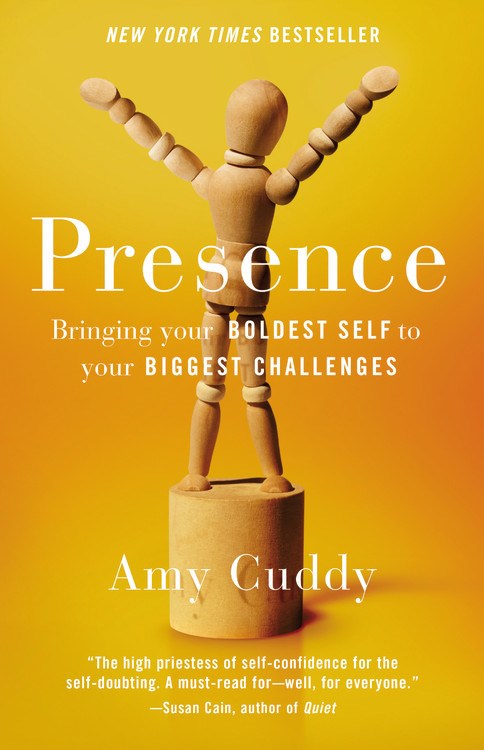-
Wired to Create: Unraveling the Mysteries of the Creative Mind
Scott Barry Kaufman and Carolyn Gregoire's new book coincided serendipitously with the death of David Bowie.
-
It's Not What You Say: How You Sell Your Message When It Matters Most
Pitch coach Michael Parker teaches how to sell our message, and ourselves, most effectively.
-

Presence: Bringing Your Boldest Self to Your Biggest Challenges
Amy Cuddy tells us how to use the power of presence to overcome our daily struggles and show up authentically ourselves.
-

Driven to Delight: Delivering World-Class Customer Experience the Mercedes-Benz Way
Joseph Michelli explores how Mercedes-Benz went from being a company that delivered great cars to people to one that delivers great customer experiences, as well.
-
We-Commerce : How to Create, Collaborate, and Succeed in the Sharing Economy
Billee Howard dispels some of the doom and gloom of recent books on technology and its effects we've covered here lately.
-
The Giving Way to Happiness: Stories and Science Behind the Life-Changing Power of Giving
Jennifer Santi has a book on the power of giving and finding happiness in it that is perfect for the season.
-
Black Box Thinking: Why Most People Never Learn from Their Mistakes—But Some Do
In his new book, Matthew Syed explains how mistakes and failures can be used to drive progress and innovation.
-
The Great Surge: The Ascent of the Developing World
Steven Radelet gives us a history of the the modern world that will lift the doom and gloom set upon us by the popular narrative in the news media.
-
Why Should Anyone Work Here: What It Takes to Create an Authentic Organization
Rob Goffee and Gareth Jones talk about how the "old paradigm has flipped" with regards to organizations and employment, and authenticity is an organizational advantage all should tap into.
-
Getting Beyond Better: How Social Entrepreneurship Works
Roger L. Martin & Sally R. Osberg define and document the growing field of social entrepreneurship.
-
America's Bank: The Epic Struggle to Create the Federal Reserve
Roger Lowenstein has written a brilliant book on the founding of the Federal Reserve that informs and echoes the issues and arguments of today.
-
Little Rice: Smartphones, Xiaomi, and the Chinese Dream
Clay Shirky dissects the state of globalization and its future by looking at the relationship of people to our smartphones, and the relationship of smartphones to the People's Republic of China.
-
Primed to Perform: How to Build the Highest Performing Cultures Through the Science of Total Motivation
Neel Doshi and Lindsay McGregor explain why play, purpose, and potential are the best drivers of motivation and performance, and how to build (and build upon) them in your organization.
-
Everybody Matters: The Extraordinary Power of Caring for Your People Like Family
In their new book, Bob Chapman and Raj Sisodia help us tap into "the extraordinary power of caring for your people like family."
-
The Silo Effect: The Peril of Expertise and the Promise of Breaking Down Barriers
In her new book, Gillian Tett teaches us how to master silos so that they won't master us.
-
Shaky Ground: The Strange Saga of the U.S. Mortgage Giants
Bethany McLean weaves a tale of Fannie Mae and Freddie Mac that enlightens, enrages, and educates.
-
Leadership BS: Fixing Workplaces and Careers One Truth at a Time
Jeffrey Pfeffer's new book is not filled with a whole lot of inspiration, and tells us why those that are can be dangerous.
-
Why We Work
Barry Schwartz discusses what motivates us to work, and how to redesign our workplaces—and human nature along with it—armed with that knowledge.
-
Humans Need Not Apply: A Guide to Wealth and Work in the Age of Artificial Intelligence
Jerry Kaplan discusses the dangers of artificial intelligence and how to prevent them from becoming a dystopic reality.
-
We Are Market Basket: The Story of the Unlikely Grassroots Movement That Saved a Beloved Business
Daniel Korschun and Grant Welker tell a beautiful story of a company's employees, suppliers, and customers starting a movement to save its soul.
-
Collaborative Intelligence: Thinking with People Who Think Differently
Angie McArthur & Dawna Markova have collaborated on a wonderful new book to teaches us all about collaborative intelligence.
-
Humans Are Underrated: What High Achievers Know That Brilliant Machines Never Will
Geoff Colvin asks (and answers) As machines get better than us at almost every task—mental and physical—what jobs will be left for us to do?
-
Shareology: How Sharing Is Powering the Human Economy
Bryan Kramer tells us that, in an increasingly digital world, the economy will become more human and be powered by a fundamental human behavior: sharing.
-
The Revenue Growth Habit: The Simple Art of Growing Your Business by 15% in 15 Minutes Per Day
Alex Goldfayn gives busy businesspeople a quick and easy way, on quick and concise chapters, to drive revenue growth.
-
Disrupt You!: Master Personal Transformation, Seize Opportunity, and Thrive in the Era of Endless Innovation
Jay Samit tells us to be successful in life and business, we must continue to be disruptive—even, or especially, to ourselves.
-
The Achievement Habit: Stop Wishing, Start Doing, and Take Command of Your Life
In his new book, Bernard Roth, a professor of engineering and academic director at Stanford's famous d. school, teaches us how to engineer a better life.
-
Team Genius: The New Science of High-Performing Organizations
Two of our favorite writers, Rich Karlgaard and Michael S. Malone, have teamed up to tell us (and teach us) about the genius of teams.
-
The Open Organization: Igniting Passion and Performance
Red Hat's CEO Jim Whitehurst shares a manifesto for reorganizing your company.
-
Your Strategy Needs a Strategy: How to Choose and Execute the Right Approach
Martin Reeves, Knut Haanaes, and Janmejaya Sinha of Boston Consulting Group provide a lesson on why our strategies need a strategy, and a guidebook to do it.
-
Let the Elephants Run: Unlock Your Creativity and Change Everything
David Usher not only tells us that creativity is a lot of hard work, he teaches us how to do the work.
-
Who Gets What—and Why by Alvin E. Roth
Alvin E. Roth's new book Who Gets What—and Why, schools us in how different markets work, and how to make them work better.
-
Misbehaving: The Making of Behavioral Economics
Sally reviews Richard Thaler's new book, Misbehaving: The Making of Behavioral Economics.
-
The Seventh Sense: How Flashes of Insight Change Your Life
William Duggan is out to teach us all about our "seventh sense," how to improve it, and change our lives for the better.
-
Triggers: Creating Behavior That Lasts—Becoming the Person You Want to Be
Marshall Goldsmith teaches us that regret can be a powerful impetus to begin behavior change, and teaches us a way to do it as adults.
-
When to Rob a Bank ... and 131 More Warped Suggestions and Well-Intended Rants
The Freakonomics phenomenon has brought a lot of lay readers to economic topics, particularly through its popular blog, the best of which is now a book!
-
Stand Out: How to Find Your Breakthrough Idea and Build a Following Around It
Dorie Clark returns with new wisdom on building your reputation as a thought leader. Find your idea—find your audience.
-
Connection Culture
In Connection Culture, Michael Lee Stallard writes about why meeting human needs is not only the right thing to do, but also leads to better business results.
-
Widgets
Widgets author Rodd Wagner tells us that "Employees are not your greatest asset" because "They're not yours, and they're not assets."
-
A Curious Mind: The Secret to a Bigger Life
A Curious Mind is, literally, that book, the right book for every reader. I cannot imagine there is anyone who would not benefit from Grazer and Fishman’s contribution to the most notable books of 2015.
-
Do the Kind Thing by Daniel Lubetzky
Daniel Lubetzky's Do the Kind Thing is a great tale of a profitable, mission-driven business, and a great reminder to stick to our foundational values.
-
Changing Your Company from the Inside Out: A Guide for Social Intrapreneurs
If corporations truly are people, then like all people it benefits us as a society if they're committed to making a social profit as well as a financial profit.
-
The High Speed Company by Jason Jennings with Laurence Haughton
Jason Jennings is one of our favorite authors, and he is back with a book about instilling a sense of urgency within your company culture.
-
Better and Faster: The Proven Path to Unstoppable Ideas
Jeremy Gutsche second great book teaches us how to avoid complacency with 6 ways to hunt for new ideas.
-
Becoming the Best: Build a World-Class Organization Through Values-Based Leadership by Harry M. Kraemer
Harry Kraemer's follow up to From Values to Action is a how-to guide to applying values-based leadership principles in your daily life.
-
The Creator's Code: The Six Essential Skills of Extraordinary Entrepreneurs
Amy Wilkinson reveals the six skills shared by all great entrepreneurs.
-
Frugal Innovation: How to Do More With Less by Navi Radjou & Jaideep Prabhu
PublicAffairs and The Economist team up with two brilliant authors to show us how to create more value with the increasingly limited resources available to us.
-
Six Capitals, or Can Accountants Save the Planet? by Jane Gleeson-White
Jane Gleeson-White explains how accountants can save the planet by taking into account more than just financial and manufactured capital.
-
The Internet Is Not the Answer by Andrew Keen
Andrew Keen explores the economic and cultural pitfalls of the Internet.
-
Work Simply: Embracing the Power of Your Personal Productivity Style by Carson Tate
Carson Tate’s mission in life is also to help us get out from underneath it all, backed by the latest cognitive science.








